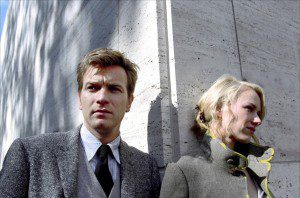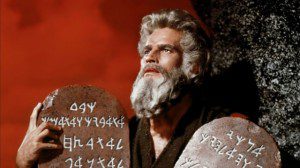 If we forget The Chronicles of Riddick — and odds are you had until I mentioned it just now — this is turning out to be a good summer for sequels, from big-budget blockbusters like Spider-Man 2 to small art-house films like Before Sunset. Somewhere between the sensibilities of those two flicks lies The Bourne Supremacy, an intelligent, action-packed thrill ride which also has the documentary-like feel of a European travelogue. Unlike, say, the James Bond films, which are loaded with product placements and pyrotechnics, and which gravitate toward famous tourist attractions like the Millennium Dome and the Eiffel Tower, the Jason Bourne movies are filmed in a more naturalistic style, and are grounded in more mundane yet familiar locations: train stations, hotels, and housing projects that are believable precisely because they don’t seem to have been dressed up for a movie.
If we forget The Chronicles of Riddick — and odds are you had until I mentioned it just now — this is turning out to be a good summer for sequels, from big-budget blockbusters like Spider-Man 2 to small art-house films like Before Sunset. Somewhere between the sensibilities of those two flicks lies The Bourne Supremacy, an intelligent, action-packed thrill ride which also has the documentary-like feel of a European travelogue. Unlike, say, the James Bond films, which are loaded with product placements and pyrotechnics, and which gravitate toward famous tourist attractions like the Millennium Dome and the Eiffel Tower, the Jason Bourne movies are filmed in a more naturalistic style, and are grounded in more mundane yet familiar locations: train stations, hotels, and housing projects that are believable precisely because they don’t seem to have been dressed up for a movie.
Matt Damon returns as Jason Bourne, the amnesia victim who discovered, two years ago in The Bourne Identity, that he was, until his memory blanked out, a highly-trained assassin working for an ultra-shadowy branch of the CIA. When last we saw him, that branch had been shut down and his boss (Chris Cooper) bumped off, and Bourne himself had turned his back on his former life and settled down to a life “off the grid” with Marie (Franka Potente), the German woman who not only helped him stay one step ahead of his former colleagues but also humanized him, making him less of a killing machine and more of a person.
Alas, any chance of a happy-ever-after is ruined when a Russian assassin named Kirill (The Lord of the Rings‘ Karl Urban) begins killing CIA operatives and leaving clues behind, including fake fingerprints, that point to Bourne. This prompts a nasty turf war between Pamela Landy (Joan Allen), the tough, focused, no-nonsense CIA director whose men were killed by Kirill, and Ward Abbott (Allen’s Manhunter co-star Brian Cox), the higher-ranking CIA boss who was once responsible for the Bourne file. Kirill also tracks Bourne down and tries to kill him, too, to keep the CIA chasing a phantom — and Bourne, who survives the attack but has no idea who Kirill is, assumes the CIA is out to get him again.
Thus begins a game of cat-and-mouse — or, rather, cat-and-cats — in which Bourne comes after the CIA bigwigs while they try to outwit him and quarrel amongst themselves over how to best deal with him when they find him. Landy wants to capture Bourne and take him alive, to complete the mission that Kirill interrupted. But Abbott would be quite happy to just kill Bourne and cut the Agency’s losses before any more damage is done.
The film, adapted from the Robert Ludlum novel by director Paul Greengrass (whose docudrama Bloody Sunday had a similarly effective cinema verité style) and writer Tony Gilroy, is to some degree little more than a series of chase sequences and fight scenes strung together with bits of conversation that serve mostly to further the plot; this film is certainly not meant to be a penetrating character study or a thought-provoking theme piece. But the filmmakers know just how to milk the most minimal of details for effect; the dialogue crackles with good lines, while Oliver Wood’s naturalistic, hand-held camera-work gives the film a you-are-there intimacy and Christopher Rouse’s fluid editing underscores the frenetic, chaotic nature of the film’s most intense chases and fight scenes.
There is, indeed, something rather moral about this film’s approach to violence that puts it several notches above such gratuitously indulgent films as, oh, say, Bad Boys II. Bourne probably spends more time running away from the authorities than getting into fights, and on the rare occasion that he has to knock someone out, he does it so quickly, with moves so lightning-fast, that you’d almost miss them if you blinked; consistent with this film’s naturalistic style, there are none of the slow-motion shots that celebrate the violence in lesser movies. The only drawn-out fights are between Bourne and his equals, and there is a rough, desperate, seemingly improvised quality to their scraps that somehow never feels sensationalistic even as it gives the audience a vicarious thrill; this is true whether Bourne is fighting hand-to-hand or butting bumpers with another man’s vehicle in a crowded tunnel, a sequence so wild, so crazy, so physical, so seemingly dangerous for cast and crew alike that it puts the airy, computer-generated tunnel chase in I, Robot completely to shame.
Notably, when one of these fights ends with a man’s agonizing death at Bourne’s hands, the camera deliberately steers our attention away from the victim to Bourne himself. In context, the death is somewhat justified, since Bourne was acting in self-defense and his reflexes took over, as it were; he did not kill the man out of any deliberate homicidal intent. And yet, looking at Bourne’s face, we sense that he has lost something by returning to this former way of life; we sense that the fact that he even has those reflexes is yet another painful reminder of the fact that he once embraced a basically evil life.
Most amnesia movies are ultimately about redemption — someone’s slate is wiped clean so that he or she can start again. But they are also often about atonement — one has to retrieve one’s memory so that one can make right the wrongs of the past. The Bourne films fit into that pattern, and what is particularly heartening about this film is that, where it could have descended into the sort of revenge dramas that have become so popular lately (Man on Fire, The Punisher, etc.), it ultimately settles for justice instead — and not just the justice that consists of putting down one’s enemies, but the justice that calls for confession, even reconciliation. For this and many other reasons, Bourne reigns supreme among current action movies.
3.5 stars (out of 4)
–
Talk About It
Discussion starters
1. When Bourne suspects the CIA is after him, he says he has no choice but to fight back, but Marie says he does have a choice. What does this film say about our choices and how we make them? What sort of freedom does Bourne have, and where does it come from?
2. Are we obliged to follow up the threats we make? Should we even make threats in the first place? Is a threat like a promise that must be kept? Is it ever a good thing to break a promise?
3. What is the difference between revenge and justice? Which is Bourne is pursuing, at different points in the story? Do you think he does enough to atone for his past sins? What else, if anything, should he do? How should we make amends for the wrongs we have done?
4. How do you think the film portrayed violence? How did the film direct our attention at various points in the fight scenes — for example, when the one man is strangled, or when the cars crash into each other, or when certain people are shot? Why do you think the film directed our attention the way it did?
The Family Corner
For parents to consider
The film is about current and former assassins, and they do a lot of punching, kicking, shooting, stabbing, threatening, and crashing of vehicles at high speeds; we see a few dead and wounded bodies, and one fight scene ends with a person being strangled to death, but his face is kept off-screen. The filmmakers also make a habit of putting the camera inside the various cars for the various crashes, beginning with one vehicle that drives off a bridge, splashes into a river and sinks underwater. The first time we see Bourne, he gets out of a bed that he is sharing with Marie, but there is no sexual activity. The characters utter occasional bad words, too.
A version of this review was first published at Christianity Today Movies.












